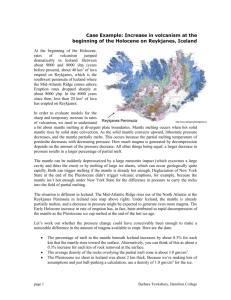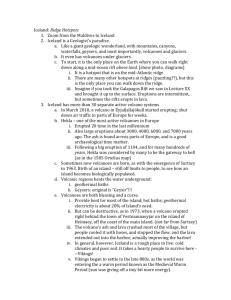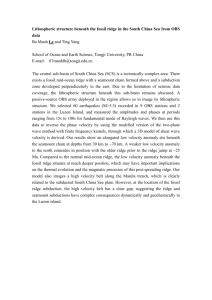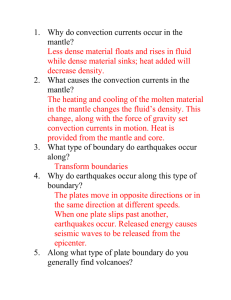OCE0436398_reyk_final
advertisement
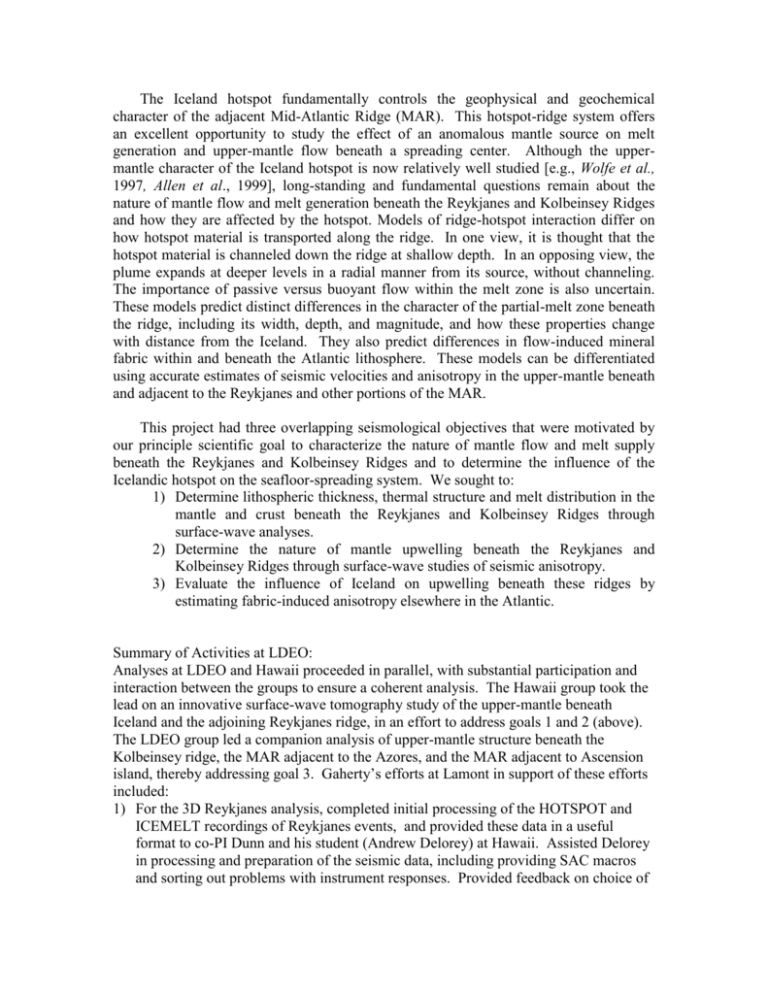
The Iceland hotspot fundamentally controls the geophysical and geochemical character of the adjacent Mid-Atlantic Ridge (MAR). This hotspot-ridge system offers an excellent opportunity to study the effect of an anomalous mantle source on melt generation and upper-mantle flow beneath a spreading center. Although the uppermantle character of the Iceland hotspot is now relatively well studied [e.g., Wolfe et al., 1997, Allen et al., 1999], long-standing and fundamental questions remain about the nature of mantle flow and melt generation beneath the Reykjanes and Kolbeinsey Ridges and how they are affected by the hotspot. Models of ridge-hotspot interaction differ on how hotspot material is transported along the ridge. In one view, it is thought that the hotspot material is channeled down the ridge at shallow depth. In an opposing view, the plume expands at deeper levels in a radial manner from its source, without channeling. The importance of passive versus buoyant flow within the melt zone is also uncertain. These models predict distinct differences in the character of the partial-melt zone beneath the ridge, including its width, depth, and magnitude, and how these properties change with distance from the Iceland. They also predict differences in flow-induced mineral fabric within and beneath the Atlantic lithosphere. These models can be differentiated using accurate estimates of seismic velocities and anisotropy in the upper-mantle beneath and adjacent to the Reykjanes and other portions of the MAR. This project had three overlapping seismological objectives that were motivated by our principle scientific goal to characterize the nature of mantle flow and melt supply beneath the Reykjanes and Kolbeinsey Ridges and to determine the influence of the Icelandic hotspot on the seafloor-spreading system. We sought to: 1) Determine lithospheric thickness, thermal structure and melt distribution in the mantle and crust beneath the Reykjanes and Kolbeinsey Ridges through surface-wave analyses. 2) Determine the nature of mantle upwelling beneath the Reykjanes and Kolbeinsey Ridges through surface-wave studies of seismic anisotropy. 3) Evaluate the influence of Iceland on upwelling beneath these ridges by estimating fabric-induced anisotropy elsewhere in the Atlantic. Summary of Activities at LDEO: Analyses at LDEO and Hawaii proceeded in parallel, with substantial participation and interaction between the groups to ensure a coherent analysis. The Hawaii group took the lead on an innovative surface-wave tomography study of the upper-mantle beneath Iceland and the adjoining Reykjanes ridge, in an effort to address goals 1 and 2 (above). The LDEO group led a companion analysis of upper-mantle structure beneath the Kolbeinsey ridge, the MAR adjacent to the Azores, and the MAR adjacent to Ascension island, thereby addressing goal 3. Gaherty’s efforts at Lamont in support of these efforts included: 1) For the 3D Reykjanes analysis, completed initial processing of the HOTSPOT and ICEMELT recordings of Reykjanes events, and provided these data in a useful format to co-PI Dunn and his student (Andrew Delorey) at Hawaii. Assisted Delorey in processing and preparation of the seismic data, including providing SAC macros and sorting out problems with instrument responses. Provided feedback on choice of modeling parameterization, model uncertainty, scientific focus, and subsequent implications. Advised a summer intern (Katie Kirsch) on a side project, modeling Pwave triplications of Reykjanes events recorded on Iceland to assess the thermal impact of hotspot on the 410 km discontinuity. Assisted with preparation of JGR manuscript on 3D structure south of Iceland. 2) Collected a large dataset of broadband recordings of earthquakes located within the Atlantic basin, recorded at seismic stations within the basin (islands) or along the Atlantic margins. Calculated synthetic seismograms for these event-station pairs, and selected a subset of these data that indicate purely oceanic paths for further analysis. Chose a data set focused on structure near ridge-centered hotspots of Iceland, Azores, and Ascension. Utilized a cross-correlation procedure to measure frequencydependent phase delays (travel times) of surface waves traversing these regions. Inverted these data for path-average models as a function of seafloor age, thereby providing a means to evaluate the variable impact of the hotspots on near-ridge thermal and anisotropic structure. Presented results in two AGU talks, posters at two IRIS workshops, and a poster at a MARGINS workshop. Lead the writing of Gcubed manuscript on comparative study of hotspot-ridge interaction in the Atlantic. Findings to date: For our 3D analysis of hotspot-ridge interaction along the Reykjanes ridge, we modeled broadband records of fundamental mode Love and Rayleigh waves that were generated by regional earthquakes occurring in the North Atlantic to the south of Iceland, and were recorded by the HOTSPOT and ICEMELT arrays and the GSN station BORG, located on Iceland. The phase, group arrival time, and amplitude information were measured for narrow-pass filtered waveforms over the period range of 9.5-100s. Over 12,000 such measurements were included in a two-part inversion for mantle and crustal shear wave velocity structure and seismic anisotropy. In a vertical plane oriented normal to the ridge axis, the shear wave velocity structure contains a broad and deep low velocity zone in the upper mantle beneath the Reykjanes Ridge. A joint analysis of the seismic structure with gravity data reveals that the low velocities are consistent with elevated temperatures (5075˚) and only a very small amount of melt (<1%). This study shows that plume material spreading outward beneath the Reykjanes Ridge from Iceland is not confined to a lithospheric channel beneath the ridge. Away from the ridge, shear wave anisotropy indicates a predominant horizontal alignment of the fast-axes of anisotropic crystals above 20-30 km depth, which can be interpreted as horizontal, ridge-perpendicular flow. However, within ±200 km of the ridge, the anisotropy indicates a general vertical alignment of the fast axes or an alignment such that the fast axes point along the ridge. The transition to this type of anisotropy coincides with the appearance of increased hotspot-ridge interaction approximately 20 Myr ago, indicating that plume flow outward from the hotspot has largely disrupted mantle corner-flow beneath the ridge. The parallel analysis of other stretches of the MAR suggests that this strong hotspot influence is largely unique to Iceland and the Reykjanes, and that the hotspot influences not only temperature and fabric along the RR, but a unique compositional structure as well. We invert frequency-dependent phase delays from MAR events recorded on Iceland, the Azores, and Ascension Island to estimate 1-D mean shear velocity and radial shear anisotropy profiles in the upper 200 km of the mantle within two seafloor age intervals: 5-10 Ma and 15-20 Ma. Mean shear velocity profiles correlate with apparent hotspot flux: lithosphere formed near the low-flux Ascension hotspot is characterized by high mantle velocities, while the MAR near the higher-flux Azores hotspot has lower velocities. The impact of the high-flux Iceland hotspot on mantle velocities along the nearby MAR is strongly asymmetric: the lithospheric velocities near the Kolbeinsey ridge are moderately slow, while velocities near the Reykjanes ridge are much slower. Within each region, the increase in shear velocity with age is consistent with a half-space cooling model, and the velocity variation observed between Ascension, the Azores, and Kolbeinsey are consistent with approximately ±75o potential-temperature variation along axis. In comparison, the Reykjanes lithosphere is too slow to result purely from halfspace cooling of a high temperature mantle source. We speculate that the anomalously low shear-velocities within the lithosphere produced at the Reykjanes ridge result from high asthenospheric temperatures of +50-75K (consistent with the 3D tomography results) combined with ~12% (by volume) gabbro retained in the mantle due to the imbalance between high hotspot-influenced melt production and relatively inefficient melt extraction along the slow-spreading Reykjanes. Radial shear anisotropy in the upper 150 km also indicates an apparent hotspot influence: mantle fabric near Ascension is quite weak, consistent with previous models of anisotropy produced by corner flow during slow seafloor spreading. The fabric near the Azores and the Kolbeinsey ridge is stronger, suggesting that the hotspot increases mantle deformation beyond that produced by slow-seafloor spreading in these regions. In none of these regions do we find evidence of the apparent vertical fabric observed beneath the Reykjanes. The asymmetry of both isotropic (thermal) and anisotropic structure between Reykjanes and Kobeinsey ridges is particularly striking – dynamic modelsof hotspot-ridge interaction must account for this asymmetry. Contributions: 1) Discipline (seismology and geodynamics): Extension of technique of modeling 2D surface-wave propagation to Rayleigh waves. Evidence that Iceland hotspot spreads broadly beneath the North Atlantic south of Iceland, with little suggestion of channeling down the ridge. Quantification of thermal anomaly in the asthenosphere beneath the Reykjanes at ~50K. Suggestion that this temperature anomaly produces excess melt that is trapped below the Moho, effectively impregnating the oceanic lithosphere with ~10% gabbro in this region. Anisotropic character along the Reykjanes suggests a strong hotspot influence, at least over the last 20 Myr. In contrast, the other stretches of hotspot influenced stretches of the MAR show only modest velocity variations that are consistent with along-axis temperature variations. 2) Other science: mantle petrologists and geochemists often assume 100% efficiency of melt extraction near ridges, despite some evidence to the contrary (e.g. Cannat and others). This study provides further evidence that the process of melt extraction is complex, and can be significantly perturbed by non-steady state behavior such as hotspot-ridge interaction. They also will be interested in the results demonstrating strong asymmetry of the seismic character of hotspot-ridge interaction north and south of Iceland; the spatial distribution of temperature variations beneath the Reykjanes; and the temperature variations inferred along the 6 stretches of the MAR. 3) Human resources: furthered the research and teaching careers of two productive scientists; provided training for a graduate student (at Hawaii) and an undergraduate student (at LDEO)

